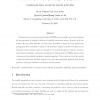Free Online Productivity Tools
i2Speak
i2Symbol
i2OCR
iTex2Img
iWeb2Print
iWeb2Shot
i2Type
iPdf2Split
iPdf2Merge
i2Bopomofo
i2Arabic
i2Style
i2Image
i2PDF
iLatex2Rtf
Sci2ools
BIOSYSTEMS
2007
2007
Homeostatic plasticity improves signal propagation in continuous-time recurrent neural networks
Continuous-time recurrent neural networks (CTRNNs) are potentially an excellent substrate for the generation of adaptive behaviour in artificial autonomous agents. However, node saturation effects in these networks can leave them insensitive to input and stop signals from propagating. Node saturation is similar to the problems of hyper-excitation and quiescence in biological nervous systems, which are thought to be avoided through the existence of homeostatic plastic mechanisms. Analogous mechanisms are implemented in CTRNNs and are shown to increase node sensitivity and improve signal propagation. These results are found in a variety of network architectures and lend support to the view that homeostatic plasticity may prevent quiescence and hyper-excitation in biological nervous systems.
| Added | 08 Dec 2010 |
| Updated | 08 Dec 2010 |
| Type | Journal |
| Year | 2007 |
| Where | BIOSYSTEMS |
| Authors | Hywel T. P. Williams, Jason Noble |
Comments (0)

